News
Tiny Art with Louise Freir
25th October 2022
25th October 2022
We were recently treated to a fabulous evening with Louise Freir who shared some of her tips for creating "tiny art".
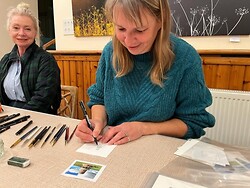
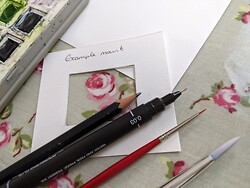
Tips for tiny art
Louise says:
After Louise’s talk and demonstration art group were inspired and so had a go doing some little tiny paintings too.
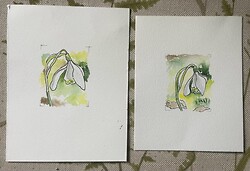
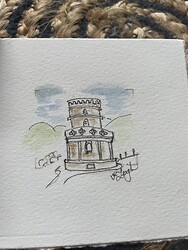
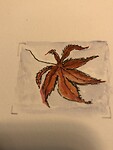
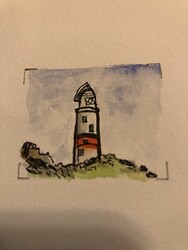
Louise also enjoys drawing architecture and some of her paintings have even gone all the way to Australia.
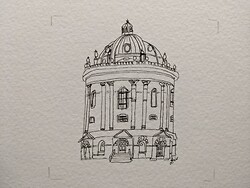
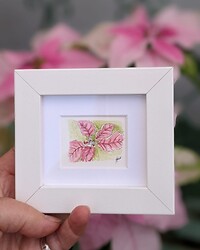
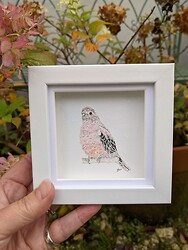
Louise welcomes commissions and you can learn more about Louise and her fabulous art work on her Instagram page @louisefreirart or drop us a line on our contacts page for more information.


Tips for tiny art
Louise says:
- Mark out your painting space using a template mount & a sharp HB pencil.
- Choose what you want to draw carefully - architecture, scene, flower?
- It is helpful if the photo or object you are drawing is the same size as your painting space (this helps with proportion).
- Use the thinnest possible pen (I use 0.03).
- Draw the basic shapes and then add in some detail.
- Don't stress about getting it accurate - miss bits out if you can't fit them in!
- Use the thinnest brush possible (I use 00000 and a larger one for the wash).
- Leave areas unpainted for the light parts, then gradually add colours and shades.
- Mount and frame your tiny art!
After Louise’s talk and demonstration art group were inspired and so had a go doing some little tiny paintings too.




Louise also enjoys drawing architecture and some of her paintings have even gone all the way to Australia.



Louise welcomes commissions and you can learn more about Louise and her fabulous art work on her Instagram page @louisefreirart or drop us a line on our contacts page for more information.
"Welcome to my world" by Elizabeth Walker
23rd October 2022
23rd October 2022
One of our Art Group members Lizzie has recently published a beautiful little book.
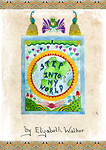
Lizzie, who has been part of the Milton Abbas Art Group for many years, has written and illustrated a series of original little stories which take their source from the natural world, the beautiful Dorset countryside and various animals.
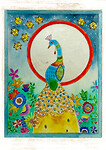
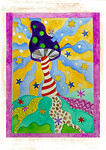
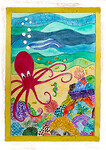
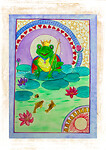
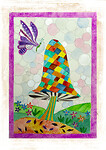
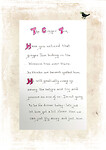
Combining her love of watercolour and creative compositions, Lizzie’s book takes us on a journey through a series of twenty charming and whimsical scenarios which are rich with the inner thoughts of animals and their various escapades which include: cunning blackbirds preparing to escape a sneaky tom cat, gannets tiring themselves out fending for their greedy baby, and hungry snails racing each other to get to a juicy cabbage. There is so much to discover on each page.
Lizzie enjoys painting in her little studio which overlooks the beautiful green fields and rolling hills close to Milborne St Andrew, and says:
”Over the years I have experimented with many different styles in my art. During lockdown I settled for fantasy paintings which resulted in me producing a little book.
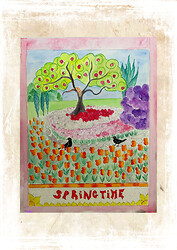
I think a light bulb switched on in my brain and each morning when I awoke a little creature popped in and said it’s my turn for a story, sometimes they bickered a bit as to whose turn it was. As you will see most of them managed to have their say (although there is still a queue!)”
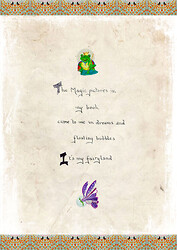
Lizzie’s book will be available for purchase for £7 during our online exhibition but stock is limited so do send a message through our contact page if you would like to reserve a copy.
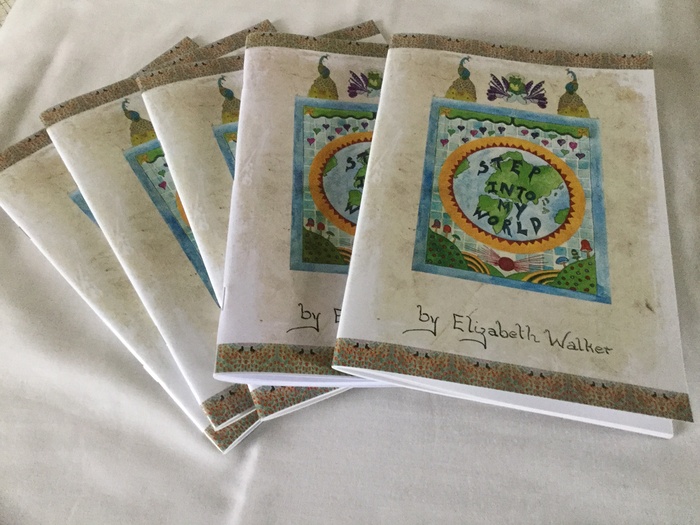
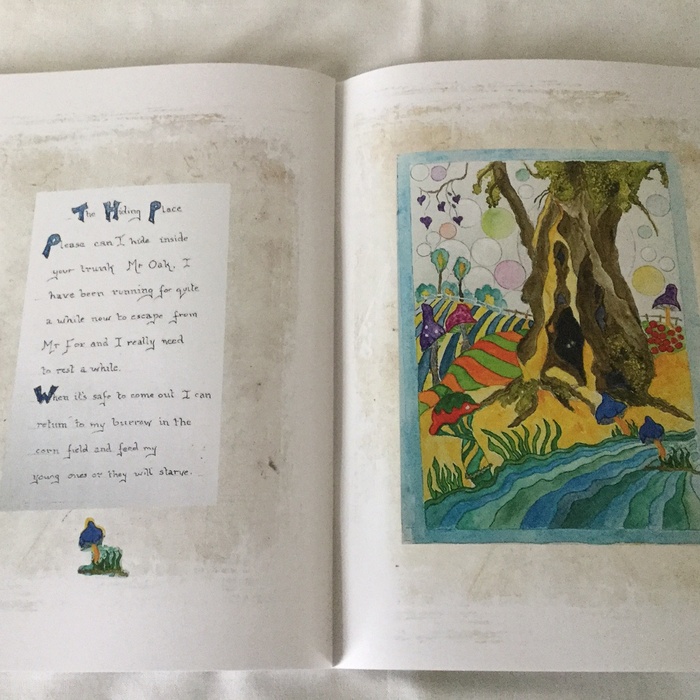

Lizzie, who has been part of the Milton Abbas Art Group for many years, has written and illustrated a series of original little stories which take their source from the natural world, the beautiful Dorset countryside and various animals.






Combining her love of watercolour and creative compositions, Lizzie’s book takes us on a journey through a series of twenty charming and whimsical scenarios which are rich with the inner thoughts of animals and their various escapades which include: cunning blackbirds preparing to escape a sneaky tom cat, gannets tiring themselves out fending for their greedy baby, and hungry snails racing each other to get to a juicy cabbage. There is so much to discover on each page.
Lizzie enjoys painting in her little studio which overlooks the beautiful green fields and rolling hills close to Milborne St Andrew, and says:
”Over the years I have experimented with many different styles in my art. During lockdown I settled for fantasy paintings which resulted in me producing a little book.

I think a light bulb switched on in my brain and each morning when I awoke a little creature popped in and said it’s my turn for a story, sometimes they bickered a bit as to whose turn it was. As you will see most of them managed to have their say (although there is still a queue!)”

Lizzie’s book will be available for purchase for £7 during our online exhibition but stock is limited so do send a message through our contact page if you would like to reserve a copy.


MAAG Artist Profile - Shulla Jaques
17th October 2022
17th October 2022
Shulla Jaques
I can’t remember not wanting to paint, though I do remember the first time it clicked that art didn’t necessarily have to be oil paintings in gold frames when in 1983 I saw the travelling exhibition of photographs by David Hockney at the Hayward Gallery. I found his montages of separate polaroid photographs to make a whole intriguing and exciting and so different from anything we were being taught. It felt thrilling and liberating. Although it’s taken nearly 40 years to get back to painting I still remind myself of this feeling when I think my art practice is becoming too prescriptive.
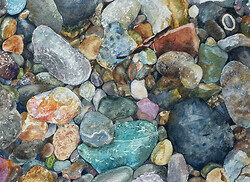
After several decades of ‘following the drum’ I feel very fortunate to have been able to return home and to settle in Dorset. Although it was tricky at first to keep the creative spark alive whilst juggling work and family commitments I was grateful to be a member of The Milton Abbas Art Group which provided the opportunity of making art even when those two-hours in the week was the only time to be a little bit creative. It was, and still is, motivating to meet like-minded artists and to learn from others.
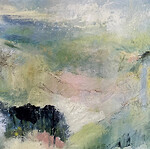
I was so lucky to have worked for a short time in the museum and cultural heritage sector as an accredited conservator of works of art on paper. Being up close to a variety of works by artists spanning the centuries from the 15th to the 20th was a privilege and an education that has really helped me understand materials and techniques.
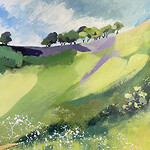
Having said that, it’s one thing knowing a little about printing and painting processes, it’s another making my own art. For the last three years I have been able to concentrate more on my art practice, taking watercolour classes with William Cooper, sketchbook workshops with Karen Stamper, collage workshops with Lewis Noble, and learning to have fun whilst exploring abstract landscape painting with Louise Fletcher and her Find Your Joy course. Most recently I have taken possession of a gelli plate and find myself lost in hours of monoprinting magic.
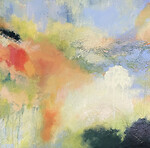
Apart from being taught art-making fundamentals regular contact with other creatives has taught me that creativity doesn’t just happen, making time to nurture your instinct to create, even if it’s a ten minute drawing every day is essential. Regular practice not only improves your technique it also helps you find you. If like me you can sometimes feel overwhelmed or have self-doubt just realising that actually the only person you should be painting (art-making) for is you – playing with new materials, exploring colour combinations, investigating different subjects, whatever interests you at the time – is a powerful release. I believe too that not trying to paint to please others makes for more authentic art.
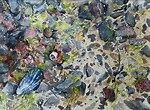
Over the last few years I have been drawn to the natural world and enjoy capturing its detail as well as responding to its ever changing character. A nod to growing up by the sea I record place and time through watercolour painting, usually on Two Rivers handmade paper, of material found on the shoreline; my interest sparked by the abstract forms and patterns encased in stones and shells. In contrast, living in an AONB and conservation area is a long way from my childhood home in a leafy suburb of Bournemouth. I have been struck by how little I knew of the changing seasons and power of the countryside. My art is therefore developing and becoming more abstract in a bid to capture my emotional response to the rural landscape through acrylic, collage and mixed media.
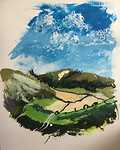
When in doubt however I remind myself that there’s always something to learn from whatever mark making or creative activity I do, the key is to just put something down on paper and if all else fails, I always have my chickens to sketch.
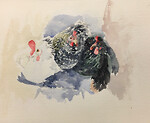
I’m taking some time out to explore botanical printing taught by local artist Caroline Soer and planning a new series of slightly larger mixed media works on board. Meanwhile, I hope you enjoy browsing the art on the website as much as I have enjoyed making my contribution.
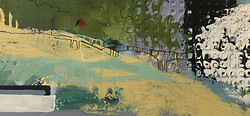
Quotes I like:
Art washes away from the soul the dust of everyday life.
Pablo Picasso
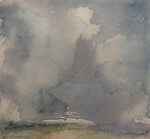
Don’t think. Thinking is the enemy of creativity. It’s self-conscious, and anything self-conscious is lousy. You can’t try to do things. You simply must do things.
Ray Bradbury
Painting from nature is not copying the object, it's realising one's sensations.
Paul Cezanne
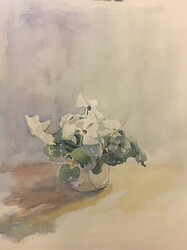
The artist must train not only his eye but also his soul. Wassily Kandinsky
He who works with his hands is a labourer. He who works with his hands and his head is a craftsman. He who works with his hands and his head and his heart is an artist.
Saint Francis of Assisi
Practice what you know and it will help you to make clear what you do not know. Rembrandt
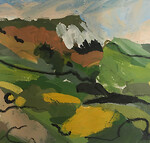
Drawing is like making an expressive gesture, with the advantage of permanence. Henri Matisse
It is only by drawing often, drawing everything, drawing incessantly, that one fine day you discover, to your surprise, that you have rendered something in its true character. Camille Pissarro
It is very good advice to believe only what an artist does, rather than what he says about his work. David Hockney
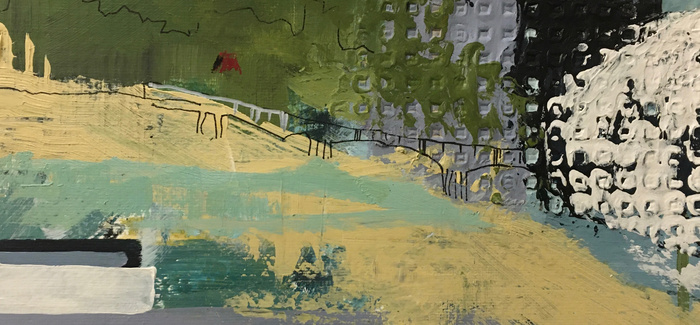
I can’t remember not wanting to paint, though I do remember the first time it clicked that art didn’t necessarily have to be oil paintings in gold frames when in 1983 I saw the travelling exhibition of photographs by David Hockney at the Hayward Gallery. I found his montages of separate polaroid photographs to make a whole intriguing and exciting and so different from anything we were being taught. It felt thrilling and liberating. Although it’s taken nearly 40 years to get back to painting I still remind myself of this feeling when I think my art practice is becoming too prescriptive.

After several decades of ‘following the drum’ I feel very fortunate to have been able to return home and to settle in Dorset. Although it was tricky at first to keep the creative spark alive whilst juggling work and family commitments I was grateful to be a member of The Milton Abbas Art Group which provided the opportunity of making art even when those two-hours in the week was the only time to be a little bit creative. It was, and still is, motivating to meet like-minded artists and to learn from others.

I was so lucky to have worked for a short time in the museum and cultural heritage sector as an accredited conservator of works of art on paper. Being up close to a variety of works by artists spanning the centuries from the 15th to the 20th was a privilege and an education that has really helped me understand materials and techniques.

Having said that, it’s one thing knowing a little about printing and painting processes, it’s another making my own art. For the last three years I have been able to concentrate more on my art practice, taking watercolour classes with William Cooper, sketchbook workshops with Karen Stamper, collage workshops with Lewis Noble, and learning to have fun whilst exploring abstract landscape painting with Louise Fletcher and her Find Your Joy course. Most recently I have taken possession of a gelli plate and find myself lost in hours of monoprinting magic.

Apart from being taught art-making fundamentals regular contact with other creatives has taught me that creativity doesn’t just happen, making time to nurture your instinct to create, even if it’s a ten minute drawing every day is essential. Regular practice not only improves your technique it also helps you find you. If like me you can sometimes feel overwhelmed or have self-doubt just realising that actually the only person you should be painting (art-making) for is you – playing with new materials, exploring colour combinations, investigating different subjects, whatever interests you at the time – is a powerful release. I believe too that not trying to paint to please others makes for more authentic art.

Over the last few years I have been drawn to the natural world and enjoy capturing its detail as well as responding to its ever changing character. A nod to growing up by the sea I record place and time through watercolour painting, usually on Two Rivers handmade paper, of material found on the shoreline; my interest sparked by the abstract forms and patterns encased in stones and shells. In contrast, living in an AONB and conservation area is a long way from my childhood home in a leafy suburb of Bournemouth. I have been struck by how little I knew of the changing seasons and power of the countryside. My art is therefore developing and becoming more abstract in a bid to capture my emotional response to the rural landscape through acrylic, collage and mixed media.

When in doubt however I remind myself that there’s always something to learn from whatever mark making or creative activity I do, the key is to just put something down on paper and if all else fails, I always have my chickens to sketch.

I’m taking some time out to explore botanical printing taught by local artist Caroline Soer and planning a new series of slightly larger mixed media works on board. Meanwhile, I hope you enjoy browsing the art on the website as much as I have enjoyed making my contribution.

Quotes I like:
Art washes away from the soul the dust of everyday life.
Pablo Picasso

Don’t think. Thinking is the enemy of creativity. It’s self-conscious, and anything self-conscious is lousy. You can’t try to do things. You simply must do things.
Ray Bradbury
Painting from nature is not copying the object, it's realising one's sensations.
Paul Cezanne

The artist must train not only his eye but also his soul. Wassily Kandinsky
He who works with his hands is a labourer. He who works with his hands and his head is a craftsman. He who works with his hands and his head and his heart is an artist.
Saint Francis of Assisi
Practice what you know and it will help you to make clear what you do not know. Rembrandt

Drawing is like making an expressive gesture, with the advantage of permanence. Henri Matisse
It is only by drawing often, drawing everything, drawing incessantly, that one fine day you discover, to your surprise, that you have rendered something in its true character. Camille Pissarro
It is very good advice to believe only what an artist does, rather than what he says about his work. David Hockney

RESOURCE: Experimental Drawing Techniques
10th October 2022
10th October 2022
Resources from a recent workshop provided for us by Richenda Oldham
Read More
Read More
Colograph printing with Ginny Lavers
12th October 2020
12th October 2020
We enjoyed a fabulous, socially distanced, evening at the club this week when Genny Lavers came to demonstrate the techniques of colograph printing.
We even had CAKE!
Genny brought along her portable printing press "Ian" who behaved beautifully.
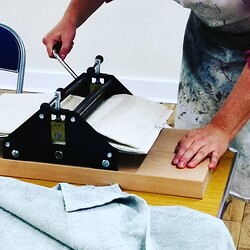
We loved seeing her beautiful work and learning more about her processes.
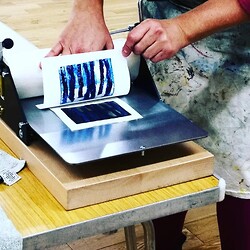
Genny is such a talented artist, who also speaks many languages and has a passion for all things tea related.
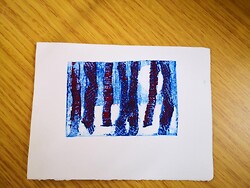
There is a link to Genny's website on our link page if you would like to learn more....
We even had CAKE!
Genny brought along her portable printing press "Ian" who behaved beautifully.

We loved seeing her beautiful work and learning more about her processes.

Genny is such a talented artist, who also speaks many languages and has a passion for all things tea related.

There is a link to Genny's website on our link page if you would like to learn more....